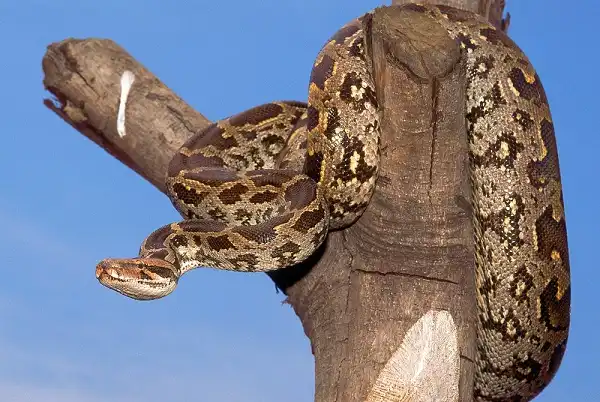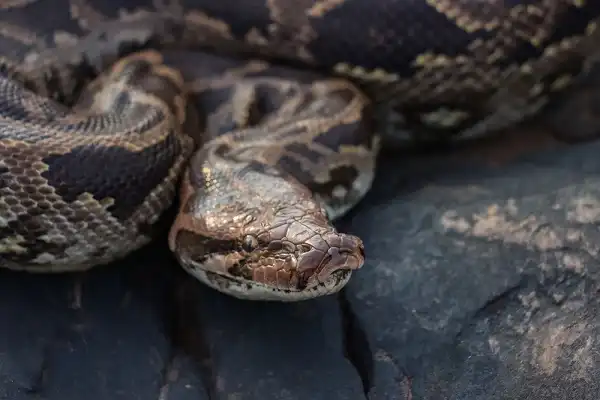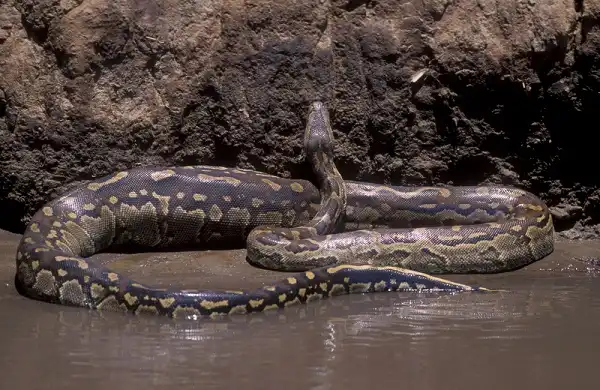In Africa, the rock python is a snake that everyone knows. It is massive and dangerous and can be found in many different habitats throughout the continent. Although they are not venomous, their size and strength make them deadly predators. In this blog post, we will explore the rock python’s natural history, including its diet, behavior, and reproduction. We’ll also take a look at how humans interact with this amazing creature.

Rock Python Description
The Rock Python is a large and powerful snake that is found throughout the African continent. The Rock Python is non-venomous, relying instead upon its formidable size to capture and constrict its prey. Its coloration consists of light or dark brown blotches on a lighter tan background. Rock Pythons can be identified by their patterned scales that range from reddish-browns to yellowish-green hues interspersed with darker spots along their sides and back. They also possess powerfully built bodies with sharp teeth arranged into curved hooks that enable them to latch onto their prey when hunting. Their eyes are large and cat-like which helps them see better in low-light environments like caves or dense vegetation. In addition to size, Rock Pythons possess incredible strength thanks to their muscular body which enables them to constrict around prey with enough force to stop its breathing entirely.
Rock Python Habitat
The Rock Python is found in a wide variety of habitats throughout Africa, including savanna, grasslands, forests, and even agricultural lands. It prefers areas with plenty of covers such as thick vegetation and rocky outcroppings in which to hide and ambush its prey. They are also quite adaptable, able to tolerate somewhat dry conditions as well as higher elevations. In terms of climate preferences, the Rock Python typically seeks out warmer temperatures. In general, they will be found further south than other snake species in any given area as they need more heat to remain active and hunt efficiently. Despite this preference for warmth, they can tolerate cooler climates during the winter months provided there is enough cover for them to stay warm. Due to their large size, the Rock Python requires a large amount of space to move around freely in order to find food and mates. Unfortunately, this means that their natural habitats are often threatened by humans through activities such as deforestation or urbanization which can lead to the destruction of these crucial ecosystems. Additionally, due to the illegal pet trade market and hunting for their meat, many populations have begun to decline significantly over recent years which has become a major conservation issue that needs addressing.
Rock Python Diet
The Rock Python is an ambush predator, meaning it waits in a concealed location to surprise unsuspecting prey. It is an opportunistic feeder which means it will eat whatever is available and can range from insects to small mammals such as rodents, to larger animals like antelope or wild pigs. They have also been known to take on reptiles, amphibians, and even other snakes. Because the Rock Python needs a large amount of energy to survive and hunt, its diet must provide enough sustenance for it to stay healthy. During the dry season when food sources are scarce, they have been known to resort to cannibalism by eating smaller individuals of their own species in order to stay alive. However, when food is plentiful they typically prefer warm-blooded animals as these provide more nutritional value than cold-blooded ones.

Rock Python Size
Rock Python size can vary depending on the age, environment, and area of origin. On average, adult Rock Pythons are between 10 and 20 feet in length, with males typically being larger than females. The longest recorded Rock Python measured 23 feet long! The weight of a Rock Python also varies greatly and is dependent on the snake’s current environment. An adult snake will typically weigh anywhere between 44 to 200 pounds, with males usually weighing more than females. When fully grown and well-fed, the largest specimens have been known to reach up to 400 pounds or more!
Rock Python Lifespan
Rock Pythons have an impressively long lifespan when compared to their size; they can live up to 30 years in the wild provided they have access to fresh water and a steady supply of nutritional sources throughout the year. This makes them one of the longest-lived snakes in Africa, second only to the equally impressive African Rock Python whose lifespan can last as long as 35 years! Their extended lifespans are due largely in part to their highly adaptable nature. As ectotherms, they are able to regulate their body temperature by seeking out warm spots during colder months when needed – this helps them survive in a range of climates from sandy deserts all the way up mountainsides where other species may struggle to survive. Another factor that contributes to their longevity is their reproductive habits; unlike many reptiles who lay eggs and abandon them, Rock Pythons take great care of their offspring often providing them with food until they become mature enough to fend for themselves. This not only increases the chances of survival for younger Rock Pythons but also ensures that more mature individuals have access to larger prey and thus better sources of nutrition over time.
Rock Python Behavior
Rock Pythons are solitary animals who spend most of their time alone. They usually hunt at night when temperatures are cooler and the dim light gives them an advantage over their prey. During the day, they often rest in burrows or trees, waiting for darkness to fall before heading out in search of food. In addition to eating, Rock Pythons also engage in courtship rituals during the mating season which typically starts during April or May depending on where they live. Males will rub against each other while emitting low guttural sounds that attract females who may come from far away to join them. If a female is interested she will stay with the male until she lays her eggs which can be anywhere between 5-30 depending on her size; once done she will then leave them under his care while she seeks out food sources of her own. The eggs take roughly two months to hatch at which point the young Rock Pythons are ready to fend for themselves; this is beneficial as overcrowding within their burrows could lead to fights between siblings which would ultimately result in death for some. After hatching, these pythons will typically remain close by until they reach adulthood at around three years old after which point they go off on their own and begin searching for mates of their own – continuing the cycle all over again!

Rock Python Speed
Rock Pythons are surprisingly fast reptiles capable of reaching speeds of up to 10 mph (16 km/h) when sprinting. This is incredibly impressive for a creature that has evolved to spend most of its life on the ground, but it’s even more incredible when one takes into account its large size. Their long, muscular bodies and powerful jaws allow them to compress their body and launch themselves forward with as much force as possible, allowing them to catch up to even the fastest prey. This is especially useful for Rock Pythons who live in mountainous areas where flat terrain can be hard to come by; instead, they utilize their speed and agility to traverse the hilly slopes quickly and efficiently in search of food. Furthermore, their quick speed also helps them escape predators if they become threatened or feel overwhelmed; this combined with their thick scales makes them difficult targets for any would-be attackers. In addition to their physical qualities, Rock Pythons have also developed an array of behavioral strategies which help maximize their speed when hunting. These include lying still until prey gets closer then rapidly pouncing forward with lightning-quick reflexes – often lunging before the animal even realizes it’s been targeted.
Rock Python Hunting
Rock Python hunting is both an art and a science. These agile snakes have adapted to their environment, honing their skills over time to become one of the most formidable predators in the reptilian world. From stalking small prey to ambushing large mammals, Rock Pythons use a wide range of tactics when hunting – all of which require patience, speed, and stealth. The most common method used by Rock Pythons when hunting smaller animals is to remain still for long periods of time until the prey gets close enough for them to strike. This requires patience as it may take a while before the animal comes within striking distance, but when it does the snake will launch itself forward with remarkable speed and accuracy – usually pouncing on its target before it has a chance to react. When successful, this technique will allow them to bring down even the fastest creatures such as mice and birds with ease.
For larger prey such as antelope or deer, Rock Pythons often opt for ambush tactics rather than chasing these animals directly. To do this they will find an area where they know these animals frequently then hide in nearby bushes or crevices until potential meals come into view. Once this happens the snakes will quickly launch themselves out of hiding and latch onto their targets with their powerful jaws – sometimes even constricting them if necessary – allowing them to bring down much bigger prey items than they would be able to if chasing them outright. Overall, Rock Pythons are incredibly skilled hunters that have strived over millions of years in order to survive in some of Earth’s harshest environments. From their lightning-quick reflexes to their ability to anticipate where potential food sources may come from these reptiles are highly intelligent creatures capable of utilizing different strategies depending on what type of meal they’re trying to find.

Conclusion
Rock Pythons are some of the most impressive predators in the world. Thanks to their thick scales, lightning-quick reflexes, and an array of different hunting strategies these snakes are able to take on a wide range of prey items – from small mammals all the way up to larger animals such as antelope. Through millions of years of evolution, they have become incredibly adaptive hunters that can survive in even some of Earth’s toughest environments. As such, Rock Pythons remain venerated creatures throughout Africa and South Asia – something that is likely to continue for many years to come.
Frequently Asked Question


